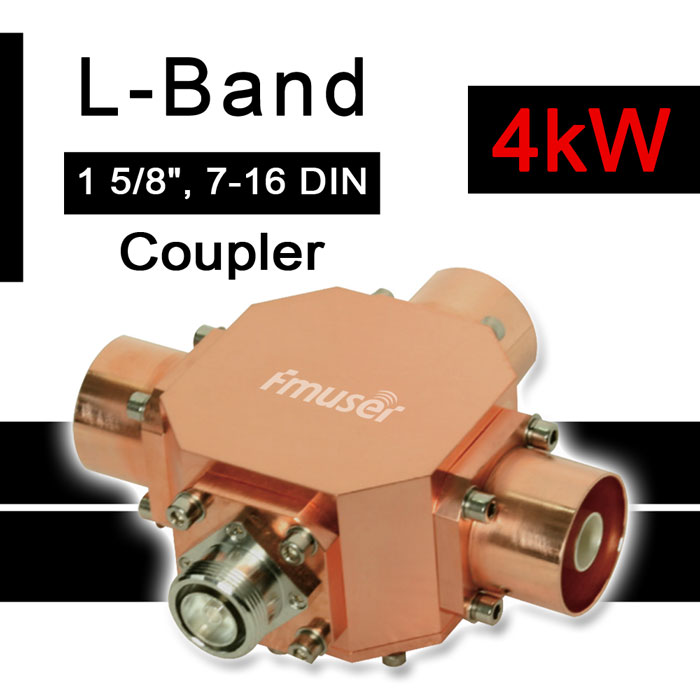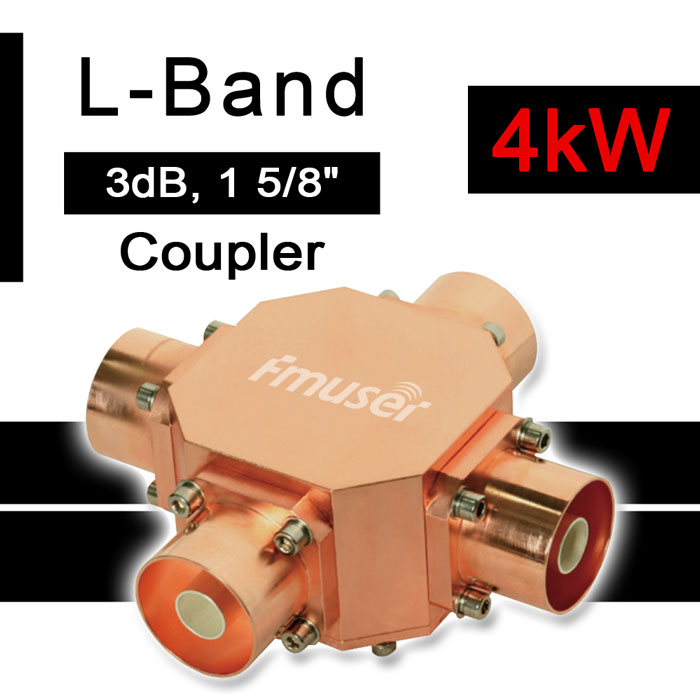
L Band Coupler
Couplers tal-medda L huma komunement użati f'varjetà ta 'applikazzjonijiet, bħal komunikazzjonijiet, radar, u sistemi tas-satellita. L-aktar applikazzjonijiet komuni ta 'l-akkoppjar tal-medda L huma li jgħaqqdu jew jaqsmu sinjali RF, jipprovdu tqabbil ta' impedenza, u jipprovdu iżolament bejn żewġ sinjali. Applikazzjonijiet oħra jinkludu monitoraġġ u ttestjar tas-sinjali, li jipprovdu qsim jew kombinazzjoni ta 'qawwa ugwali, jipprovdu iżolament u protezzjoni, u jipprovdu ekwalizzazzjoni tal-qligħ.
- X'inhu coupler L-band, u x'inhu sinonimu tiegħu?
- Coupler tal-banda L huwa apparat li jintuża biex jgħaqqad jew jgħaqqad sinjali multipli f'medda ta' frekwenza speċifika (1 sa 2 GHz). Huwa magħruf ukoll bħala coupler ta 'faxxa baxxa.
- Kif tuża coupler L-band għax-xandir?
- Passi biex tuża b'mod korrett coupler L-band fi stazzjon tax-xandir:
1. Qabbad il-coupler L-band mal-kejbil koassjali tal-istazzjon tax-xandir.
2. Kun żgur li l-coupler huwa allinjat sew u li l-konnetturi huma mwaħħla sew.
3. Kun żgur li s-sinjal ikun għaddej mill-coupler billi twettaq test tas-sinjal.
4. Ikkalibra l-coupler għal-livelli u frekwenzi korretti.
5. Tissorvelja l-output tas-sinjal biex tiżgura li ma tkunx degradata wara li tgħaddi mill-coupler.
Problemi li għandhom jiġu evitati meta tuża coupler L-band fi stazzjon tax-xandir:
1. Evita li tikkonnettja u skonnettja l-coupler spiss wisq, peress li dan jista 'jikkawża ħsara lill-konnetturi.
2. Kun żgur li l-coupler ma jkunx mgħobbi żżejjed b'ħafna sinjal, peress li dan jista 'jnaqqas il-kwalità tas-sinjal.
3. Kun żgur li twaħħal sew il-coupler biex tevita kwalunkwe interferenza minn sorsi oħra.
4. Kun żgur li l-coupler jinżamm 'il bogħod minn kwalunkwe sors ta' sħana jew umdità.
- Kif jaħdem coupler L-band?
- A coupler L-band huwa apparat użat fl-istazzjonijiet tax-xandir li huwa użat biex jgħaqqad sinjali multipli f'sinjal wieħed. Juża coupler direzzjonali biex jissepara s-sinjali, li jippermettilhom jingħaqdu f'sinjal wieħed. Dan huwa utli biex tgħaqqad sinjali minn trasmettituri differenti, li jippermetti li jixxandar sinjal aktar b'saħħtu.
- Għaliex huwa importanti coupler L-band għal stazzjon tar-radju?
- A coupler L-Band huwa mezz importanti għaliex jippermetti stazzjon tax-xandir jittrasmetti sinjali u jirċevihom fi frekwenzi differenti. Dan huwa meħtieġ għaliex jippermetti lill-istazzjon ixandar kanali multipli u jamministra l-interferenza bejn sinjali differenti. Mingħajr il-coupler L-Band, ikun diffiċli għall-istazzjon tax-xandir li jimmaniġġja sinjali multipli fl-istess medda ta 'frekwenza.
- Kemm-il tip ta' couplers tal-faxxa L hemm u x'inhuma d-differenzi bejniethom?
- Hemm tliet tipi ta ' couplers L-band: Wilkinson, ferrite, u ibridi. Id-differenzi bejniethom huma primarjament f'termini ta 'immaniġġjar ta' enerġija, firxa ta 'frekwenza, telf ta' inserzjoni, iżolament u telf ta 'ritorn. Il-couplers Wilkinson għandhom l-ogħla firxa tal-immaniġġjar tal-qawwa u l-firxa tal-frekwenza, filwaqt li l-couplers tal-ferrite għandhom l-inqas telf ta 'inserzjoni u l-ogħla iżolament. Couplers ibridi għandhom l-aħjar prestazzjoni ta 'telf ta' ritorn.
- Kif tagħżel l-aħjar coupler L-band?
- Meta tagħżel l-aħjar coupler L-band għal stazzjon tax-xandir, huwa importanti li tikkunsidra d-daqs, il-klassifikazzjoni tal-qawwa u l-firxa tal-frekwenza tal-coupler. Barra minn hekk, għandek tirriċerka l-manifattur biex tiżgura li l-prodotti tagħhom huma affidabbli u ta 'kwalità għolja. Huwa wkoll importanti li tikkunsidra l-konnetturi użati fuq il-coupler u tiżgura li huma kompatibbli mat-tagħmir tal-istazzjon tax-xandir. Fl-aħħarnett, kun żgur li tqabbel il-prezzijiet u aqra reviżjonijiet tal-klijenti biex tiżgura li qed tieħu l-aktar valur għal flusek.
- Kif tikkonnettja b'mod korrett coupler L-band fis-sistema tax-xandir?
- 1. Sib il-coupler tal-banda L u l-port tad-dħul tal-antenna.
2. Qabbad il-kejbil koassjali mill-port tad-dħul ta 'l-antenna mal-coupler tal-medda L.
3. Waħħal il-coupler tal-banda L mal-antenna.
4. Qabbad it-tarf l-ieħor tal-kejbil koassjali ma 'trasmettitur jew riċevitur.
5. Sikura l-konnessjonijiet kollha u żgura li l-konnessjonijiet huma ssikkati.
6. Ittestja l-konnessjonijiet biex tiżgura li s-sistema qed taħdem sew.
- X'tagħmir huwa relatat ma' coupler L-band?
- It-tagħmir relatat ma' coupler tal-medda L fi stazzjon tax-xandir tipikament jinkludi trasmettitur, riċevitur, antenna, kejbil koassjali, iżolatur u amplifikatur tal-qawwa.
- X'inhuma l-aktar speċifikazzjonijiet fiżiċi u RF importanti ta' coupler tal-medda L?
- L-aktar speċifikazzjonijiet fiżiċi u RF importanti ta’ coupler L-band jinkludu:
-Firxa ta 'frekwenza: 950-1450 MHz
-Telf ta 'Inserzjoni: ≤ 0.25 dB
-Iżolament: ≥ 25 dB
-VSWR: ≤ 1.15:1
-Immaniġġjar tal-Enerġija: ≤ 10W
-Tip ta 'Konnettur: Female / Male tat-tip N
- Kif inti żżomm korrettament coupler L-band bħala inġinier?
- Biex twettaq b'mod korrett il-manutenzjoni ta 'kuljum ta' coupler L-band fi stazzjon tax-xandir, inġinier għandu l-ewwel jispezzjona l-coupler għal kwalunkwe ħsara fiżika, bħal konnessjonijiet laxki jew korrużjoni. Imbagħad, għandhom jiċċekkjaw il-livelli tal-qawwa tal-coupler u jaġġustawhom kif meħtieġ. Wara dan, għandhom jispezzjonaw is-sinjali tal-output tal-coupler biex jiżguraw li huma kollha fil-medda aċċettata. Fl-aħħarnett, għandhom jiċċekkjaw l-impedenza tat-terminazzjoni tal-coupler u jaġġustawha jekk meħtieġ.
- Kif isewwi coupler L-band jekk ma jkunx qed jaħdem?
- Biex tissewwa coupler L-band, ser ikollok bżonn tibda billi tidentifika s-sors tal-problema. Dan jista 'jinkludi l-eżaminazzjoni tal-konnessjonijiet, il-verifika għal interferenza elettrika, u l-ittestjar għal ċirkwit qasir. Ladarba l-kawża tan-nuqqas tkun ġiet identifikata, il-partijiet meħtieġa jistgħu jiġu sostitwiti. Jekk il-coupler ikun falla minħabba parti miksura, allura l-parti għandha tiġi sostitwita b'waħda ġdida li tkun kompatibbli mas-sistema. Meta tissostitwixxi l-parti, huwa importanti li tiżgura li l-parti tkun imqabbda sew u ma ssirx ħsara bl-ebda mod. Wara li jsir dan, is-sistema għandha tiġi ttestjata biex tiżgura li qed taħdem b'mod korrett.
- Kif tagħżel l-imballaġġ it-tajjeb għal coupler L-band?
- Meta tagħżel l-ippakkjar għal coupler L-band, huwa importanti li tagħżel imballaġġ li huwa ddisinjat biex jipproteġi l-apparat minn xokkijiet esterni, vibrazzjonijiet u temperaturi estremi. Barra minn hekk, huwa importanti li tagħżel imballaġġ li jkun issiġillat sew biex jipprevjeni l-umdità u t-trab milli jidħlu fl-apparat. Waqt it-trasport, huwa importanti li jiġi żgurat li l-kaxxa hija mwaħħla sew u ttikkettjata għat-tip ta 'apparat ġewwa u li l-ambjent ma jkunx sħun jew kiesaħ wisq.
- Liema materjal jintuża għall-kisi ta 'l-irbit tal-faxxa L?
- Il-kisi ta 'coupler tal-faxxa L huwa ġeneralment magħmul minn aluminju jew plastik. Il-materjal innifsu ma jaffettwax il-prestazzjoni tal-coupler, iżda jekk il-materjal ma jkunx ta 'kwalità għolja jista' jkollu impatt fuq il-prestazzjoni.
- X'inhi l-istruttura bażika ta 'l-igganċjar tal-medda L?
- L-istruttura bażika ta 'coupler tal-medda L tikkonsisti f'erba' komponenti ewlenin: linja ta 'trażmissjoni, waveguide, coupler direzzjonali u riflettur. Il-linja ta 'trażmissjoni ġġorr is-sinjal RF u hija konnessa mal-port tad-dħul tal-gwida tal-mewġ. Il-waveguide jipprovdi iżolament bejn il-linja ta 'trasmissjoni u l-coupler direzzjonali. Il-coupler direzzjonali jintuża biex jaqsam is-sinjal f'żewġ partijiet, li waħda minnhom tintbagħat lill-port tal-ħruġ u l-oħra hija riflessa lura lir-riflettur. Ir-riflettur jintuża biex jirrifletti s-sinjal lura lejn il-port tad-dħul sabiex ikun jista 'jerġa' jintbagħat lill-port tal-ħruġ.
Il-linja ta 'trażmissjoni, il-gwida tal-mewġ u l-coupler direzzjonali kollha jiddeterminaw l-attributi u l-prestazzjoni tal-coupler tal-medda L. Mingħajr l-ebda waħda minn dawn l-istrutturi, il-coupler tal-faxxa L ma jkunx jista 'jaħdem b'mod normali.
- Min għandu jiġi assenjat biex iħaddem coupler L-band?
- Fi stazzjon tax-xandir, inġinier tax-xandir għandu jiġi assenjat biex jimmaniġġja coupler tal-banda L. Din il-persuna għandu jkollha għarfien tax-xogħol tal-elettronika tax-xandir, tkun kapaċi ssolvi l-problemi u ssewwa l-problemi bil-coupler, u tkun kapaċi tifhem u tinterpreta speċifikazzjonijiet tekniċi. Barra minn hekk, għandu jkollhom ħiliet ta 'komunikazzjoni u organizzattivi tajbin.
IKKUNTATJANA


GRUPP INTERNAZZJONALI FMUSER LIMITED.
Aħna dejjem nipprovdu lill-klijenti tagħna prodotti affidabbli u servizzi meqjusa.
Jekk tixtieq iżżomm kuntatt magħna direttament, jekk jogħġbok mur fuq Ikkuntatjana





